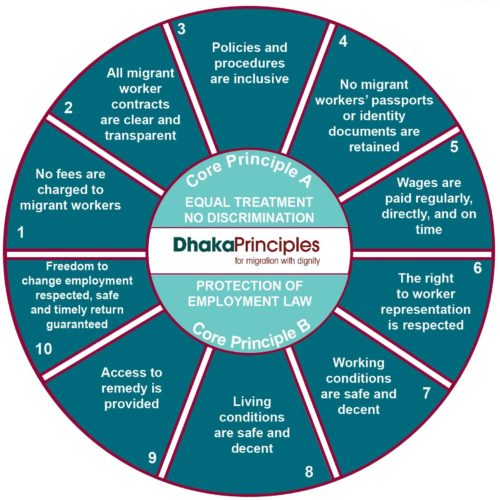-
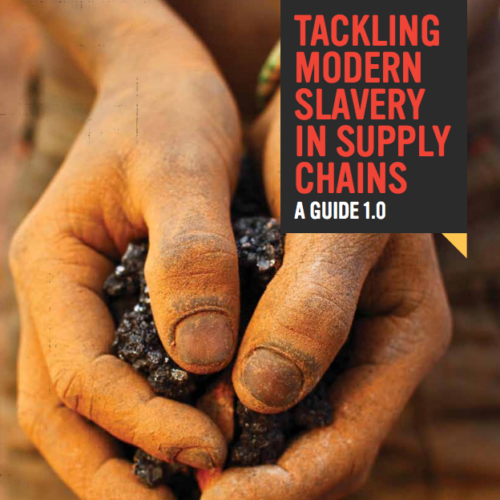 The Walk Free Foundation was established by Andrew Forrest, the Chairman of Fortescue Metals Group, after he found labour exploitation within his own supply chains and took a number of steps to prevent modern slavery affecting his business. This comprehensive guide considers corporate policy on modern slavery and provides both guidance and tools to implement it. It includes advice on corporate policy and provides template examples of a number of tools.
The Walk Free Foundation was established by Andrew Forrest, the Chairman of Fortescue Metals Group, after he found labour exploitation within his own supply chains and took a number of steps to prevent modern slavery affecting his business. This comprehensive guide considers corporate policy on modern slavery and provides both guidance and tools to implement it. It includes advice on corporate policy and provides template examples of a number of tools.Credit: Walk Free Foundation and Verite
-
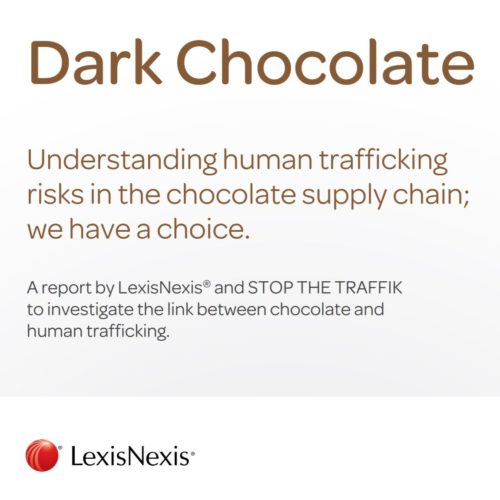 LexisNexis and STOP THE TRAFFIK produced this report after an investigation into the link between chocolate and human trafficking. The report is aimed at consumers seeking to better understand the products they consume, those working with suppliers and NGOs seeking to understand how media cover societal issues.
LexisNexis and STOP THE TRAFFIK produced this report after an investigation into the link between chocolate and human trafficking. The report is aimed at consumers seeking to better understand the products they consume, those working with suppliers and NGOs seeking to understand how media cover societal issues.Credit: Lexis Nexis and Stop the Traffik
-
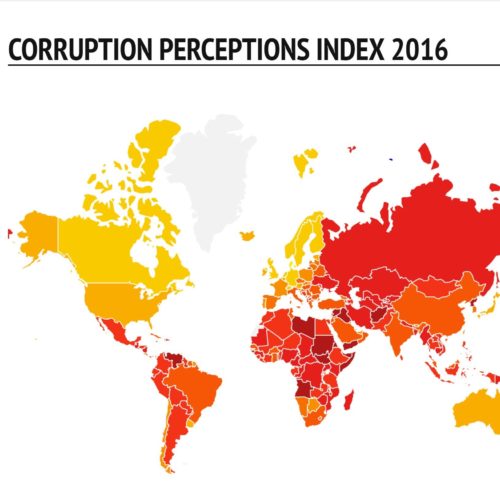 Transparency International (TI) works with governments, business and citizens to give voice to the victims and witnesses of corruption and stop the abuse of power, bribery and secret deals. TI has published the Corruption Perceptions Index since 1996, annually ranking countries by their perceived levels of corruption, as determined by expert assessments and opinion surveys. Over two-thirds of the 176 countries and territories in this year's Corruption Perceptions Index index fall below the midpoint of their scale of 0 (highly corrupt) to 100 (very clean).
Transparency International (TI) works with governments, business and citizens to give voice to the victims and witnesses of corruption and stop the abuse of power, bribery and secret deals. TI has published the Corruption Perceptions Index since 1996, annually ranking countries by their perceived levels of corruption, as determined by expert assessments and opinion surveys. Over two-thirds of the 176 countries and territories in this year's Corruption Perceptions Index index fall below the midpoint of their scale of 0 (highly corrupt) to 100 (very clean).Credit: Transparency International
-
 The Walk Free Foundation was established by Andrew Forrest, the Chairman of Fortescue Metals Group, after he found labour exploitation within his own supply chains and took a number of steps to prevent modern slavery affecting his business. This comprehensive guide considers corporate policy on modern slavery and provides both guidance and tools to implement it. It includes advice on corporate policy and provides template examples of a number of tools.
The Walk Free Foundation was established by Andrew Forrest, the Chairman of Fortescue Metals Group, after he found labour exploitation within his own supply chains and took a number of steps to prevent modern slavery affecting his business. This comprehensive guide considers corporate policy on modern slavery and provides both guidance and tools to implement it. It includes advice on corporate policy and provides template examples of a number of tools.Credit: Walk Free Foundation & Verite
-
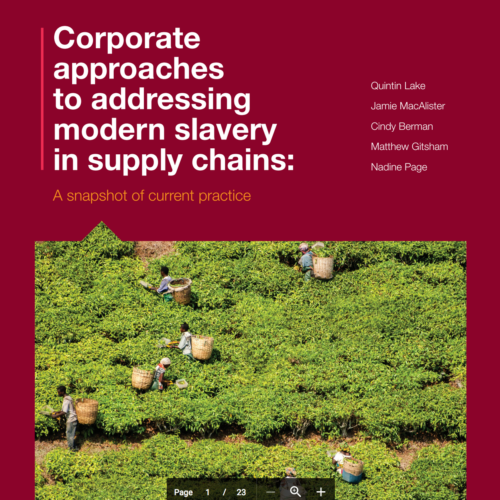 The ETI is an alliance of companies, trade unions and NGOs that promotes workers' rights around the world. This report is the outcome of interviews and surveys with 21 retailers and tier 1 companies across a range of sectors. It is intended to reflect current practice of companies regarding modern slavery and condenses findings into 10 key messages. It is not meant as formal guidance for the industry, but more to provide insight from both ETI and non-ETI members.
The ETI is an alliance of companies, trade unions and NGOs that promotes workers' rights around the world. This report is the outcome of interviews and surveys with 21 retailers and tier 1 companies across a range of sectors. It is intended to reflect current practice of companies regarding modern slavery and condenses findings into 10 key messages. It is not meant as formal guidance for the industry, but more to provide insight from both ETI and non-ETI members.Credit: Ethical Trading Initiative (ETI)
-
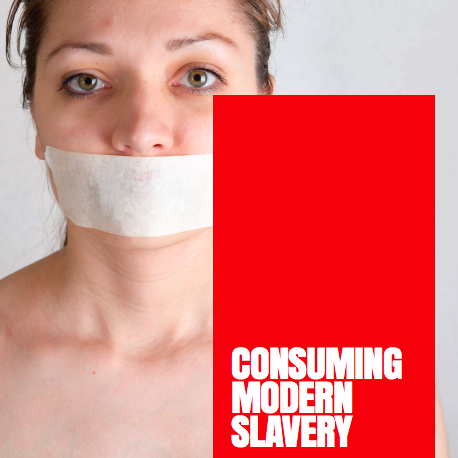 This report investigates how consumers understand modern slavery and their role in perpetuating and/or eradicating modern slavery. It is organised into three sections. The first section focuses on consumer perceptions of modern slavery, the second on consumer accounts and justifications for (widespread) inaction in relation to modern slavery, and the third on questions of consumer trust and responsibility within a multi-stakeholder environment. For each section findings are combined with related prior academic research and suggestions for change are made.
This report investigates how consumers understand modern slavery and their role in perpetuating and/or eradicating modern slavery. It is organised into three sections. The first section focuses on consumer perceptions of modern slavery, the second on consumer accounts and justifications for (widespread) inaction in relation to modern slavery, and the third on questions of consumer trust and responsibility within a multi-stakeholder environment. For each section findings are combined with related prior academic research and suggestions for change are made.Credit: University of Glasgow, University of Melbourne, Royal Holloway University of London
-
 Stronger Together is a multi-stakeholder initiative which aims to reduce modern slavery. It provides guidance, training and resources to organisations, employers, labour providers, workers and their representatives. This free collection of resources includes pragmatic guidance and toolkits, and resources for the workplace including multilingual posters, leaflets and template policies. This template is to be modified as required and for inclusion with a wider Tackling Modern Slavery in Business and Supply Chain or Business Human Rights Policy.
Stronger Together is a multi-stakeholder initiative which aims to reduce modern slavery. It provides guidance, training and resources to organisations, employers, labour providers, workers and their representatives. This free collection of resources includes pragmatic guidance and toolkits, and resources for the workplace including multilingual posters, leaflets and template policies. This template is to be modified as required and for inclusion with a wider Tackling Modern Slavery in Business and Supply Chain or Business Human Rights Policy.Credit: Stronger Together
-
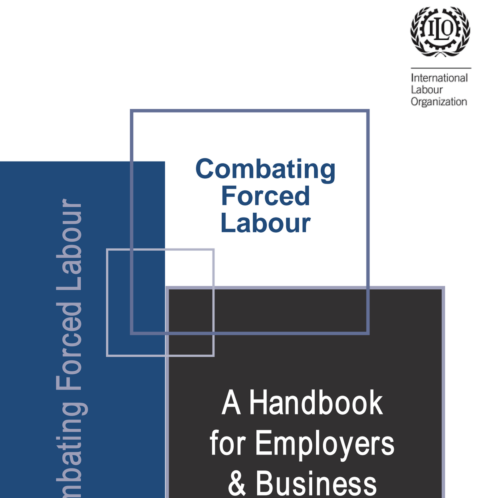 The ILO is the UN organisation responsible for setting and monitoring international labour standards. This handbook is intended as a resource for employers to coordinate a response to the risk of forced labour and human trafficking in supply chains. It is also intended to help strengthen capacity to address issues in operations and global supply chains. It provides employees and employers at different levels of business with guidance and tools to address the issue, and to identify and prevent trafficking.
The ILO is the UN organisation responsible for setting and monitoring international labour standards. This handbook is intended as a resource for employers to coordinate a response to the risk of forced labour and human trafficking in supply chains. It is also intended to help strengthen capacity to address issues in operations and global supply chains. It provides employees and employers at different levels of business with guidance and tools to address the issue, and to identify and prevent trafficking.Credit: International Labour Organisation (ILO)
-
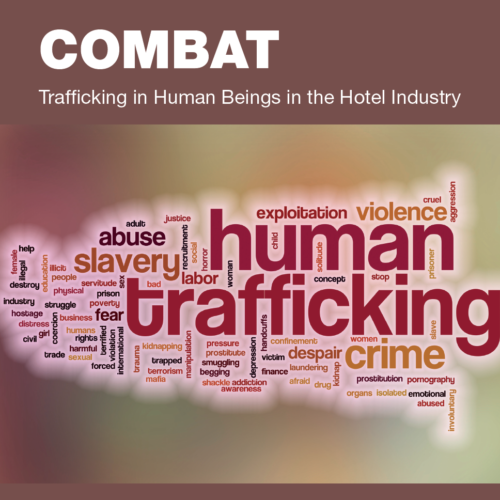 The COMBAT Toolkit is designed specifically to help hotels tackle the problem of human trafficking by helping staff to identify specific signs of trafficking. It comprises reference guides with accompanying powerpoints, case studies with accompanying powerpoint for training sessions, a trainer's manual, a series of 10-minute trainers, aide memoires and example awareness-raising posters. These 10-minute long trainers are designed and tailored as training materials both for those working outside the industry, and for staff working in hotels. Some are department specific such as food and beverage or management, others are more generic. There is also a trainer to educate more generally on how to spot the signs of trafficking in hotels. These are intended for managers and shift leaders to offer as short training at the beginning of shifts, for the trainer to offer as a refresher or as entry into deeper discussion on specific issues.
The COMBAT Toolkit is designed specifically to help hotels tackle the problem of human trafficking by helping staff to identify specific signs of trafficking. It comprises reference guides with accompanying powerpoints, case studies with accompanying powerpoint for training sessions, a trainer's manual, a series of 10-minute trainers, aide memoires and example awareness-raising posters. These 10-minute long trainers are designed and tailored as training materials both for those working outside the industry, and for staff working in hotels. Some are department specific such as food and beverage or management, others are more generic. There is also a trainer to educate more generally on how to spot the signs of trafficking in hotels. These are intended for managers and shift leaders to offer as short training at the beginning of shifts, for the trainer to offer as a refresher or as entry into deeper discussion on specific issues.Credit: COMBAT
Spotting the Signs _________________________________________________________________ For Public Authorities For Corporates For Employees: For Management For Food & Beverage For Front Office For Housekeeping -
 The COMBAT Toolkit is designed specifically to help hotels tackle the problem of human trafficking by helping staff to identify specific signs of trafficking. It comprises reference guides with accompanying powerpoints, case studies with accompanying powerpoint for training sessions, a trainer's manual, a series of 10-minute trainers, aide memoires and example awareness-raising posters. This training manual provides an overview of the Toolkit, and is a supporting document providing guidance on setting training objectives according to participants' level of knowledge, and the time available to participants. With that in mind it emphasises the necessity to tailor your training plan accordingly with guidance on delivery (presentations and materials), questions and answers, group interaction and activities.
The COMBAT Toolkit is designed specifically to help hotels tackle the problem of human trafficking by helping staff to identify specific signs of trafficking. It comprises reference guides with accompanying powerpoints, case studies with accompanying powerpoint for training sessions, a trainer's manual, a series of 10-minute trainers, aide memoires and example awareness-raising posters. This training manual provides an overview of the Toolkit, and is a supporting document providing guidance on setting training objectives according to participants' level of knowledge, and the time available to participants. With that in mind it emphasises the necessity to tailor your training plan accordingly with guidance on delivery (presentations and materials), questions and answers, group interaction and activities.Credit: COMBAT
-
 The COMBAT Toolkit is designed specifically to help hotels tackle the problem of human trafficking by helping staff to identify specific signs of trafficking. It comprises reference guides with accompanying powerpoints, case studies with accompanying powerpoint for training sessions, a trainer's manual, a series of 10-minute trainers, aide memoires and example awareness-raising posters. The following links to reference guides accompanied by slides consist of what different staff members should know about trafficking; it provides the background to human trafficking, and offers practical advice on the development of policies and procedures to counteract and disrupt trafficking and support victims. It offers trainers a ‘pick and mix’ approach so that they can tailor the contents to meet the needs of their training audience.
The COMBAT Toolkit is designed specifically to help hotels tackle the problem of human trafficking by helping staff to identify specific signs of trafficking. It comprises reference guides with accompanying powerpoints, case studies with accompanying powerpoint for training sessions, a trainer's manual, a series of 10-minute trainers, aide memoires and example awareness-raising posters. The following links to reference guides accompanied by slides consist of what different staff members should know about trafficking; it provides the background to human trafficking, and offers practical advice on the development of policies and procedures to counteract and disrupt trafficking and support victims. It offers trainers a ‘pick and mix’ approach so that they can tailor the contents to meet the needs of their training audience.Credit: COMBAT
For Hotel Management For Corporate Boards For Hotel Staff -
 The COMBAT Toolkit is designed specifically to help hotels tackle the problem of human trafficking by helping staff to identify specific signs of trafficking. It comprises reference guides with accompanying powerpoints, case studies with accompanying powerpoint for training sessions, a trainer's manual, a series of 10-minute trainers, aide memoires and example awareness-raising posters. These example posters can be reproduced and distributed around hotels to raise awareness of human trafficking and encourage reporting via appropriate channels. They come from a range of campaigns (some non-English) and are intended for back-of-house display to hotel employees.
The COMBAT Toolkit is designed specifically to help hotels tackle the problem of human trafficking by helping staff to identify specific signs of trafficking. It comprises reference guides with accompanying powerpoints, case studies with accompanying powerpoint for training sessions, a trainer's manual, a series of 10-minute trainers, aide memoires and example awareness-raising posters. These example posters can be reproduced and distributed around hotels to raise awareness of human trafficking and encourage reporting via appropriate channels. They come from a range of campaigns (some non-English) and are intended for back-of-house display to hotel employees.Credit: COMBAT
-
 The COMBAT Toolkit is designed specifically to help hotels tackle the problem of human trafficking by helping staff to identify specific signs of trafficking. It comprises reference guides with accompanying powerpoints, case studies with accompanying powerpoint for training sessions, a trainer's manual, a series of 10-minute trainers, aide memoires and example awareness-raising posters. COMBAT's seven case studies are written in the first person, so that trainees are better able to identify with victims. These case studies are intended to provide discussion point for trainees to identify whether or not the case is an example of human trafficking, what signals there are if so, and what barriers could be erected to prevent this example from happening in their hotel.
The COMBAT Toolkit is designed specifically to help hotels tackle the problem of human trafficking by helping staff to identify specific signs of trafficking. It comprises reference guides with accompanying powerpoints, case studies with accompanying powerpoint for training sessions, a trainer's manual, a series of 10-minute trainers, aide memoires and example awareness-raising posters. COMBAT's seven case studies are written in the first person, so that trainees are better able to identify with victims. These case studies are intended to provide discussion point for trainees to identify whether or not the case is an example of human trafficking, what signals there are if so, and what barriers could be erected to prevent this example from happening in their hotel.Credit: COMBAT
-
 The COMBAT Toolkit is designed specifically to help hotels tackle the problem of human trafficking by helping staff to identify specific signs of trafficking. It comprises reference guides with accompanying powerpoints, case studies with accompanying powerpoint for training sessions, a trainer's manual, a series of 10-minute trainers, aide memoires and example awareness-raising posters. These three case studies about sexual exploitation are written in the first person, so that trainees are better able to identify with victims. These case studies are intended to provide discussion point for trainees to identify whether or not the case is an example of human trafficking, what signals there are if so, and what barriers could be erected to prevent this example from happening in their hotel.
The COMBAT Toolkit is designed specifically to help hotels tackle the problem of human trafficking by helping staff to identify specific signs of trafficking. It comprises reference guides with accompanying powerpoints, case studies with accompanying powerpoint for training sessions, a trainer's manual, a series of 10-minute trainers, aide memoires and example awareness-raising posters. These three case studies about sexual exploitation are written in the first person, so that trainees are better able to identify with victims. These case studies are intended to provide discussion point for trainees to identify whether or not the case is an example of human trafficking, what signals there are if so, and what barriers could be erected to prevent this example from happening in their hotel.Credit: COMBAT
Georgia's Story: Sexual Exploitation Abigail's Story: Child Sexual Exploitation Estella and Angelica's Story: Domestic and Sexual Exploitation -
 The COMBAT Toolkit is designed specifically to help hotels tackle the problem of human trafficking by helping staff to identify specific signs of trafficking. It comprises reference guides with accompanying powerpoints, case studies with accompanying powerpoint for training sessions, a trainer's manual, a series of 10-minute trainers, aide memoires and example awareness-raising posters. These three case case studies about bonded labour are written in the first person, so that trainees are better able to identify with victims. These case studies are intended to provide discussion point for trainees to identify whether or not the case is an example of human trafficking, what signals there are if so, and what barriers could be erected to prevent this example from happening in their hotel. Credit: COMBAT Case Study 1: Osama Case Study 2: Matus Case Study 3: Cabdi
The COMBAT Toolkit is designed specifically to help hotels tackle the problem of human trafficking by helping staff to identify specific signs of trafficking. It comprises reference guides with accompanying powerpoints, case studies with accompanying powerpoint for training sessions, a trainer's manual, a series of 10-minute trainers, aide memoires and example awareness-raising posters. These three case case studies about bonded labour are written in the first person, so that trainees are better able to identify with victims. These case studies are intended to provide discussion point for trainees to identify whether or not the case is an example of human trafficking, what signals there are if so, and what barriers could be erected to prevent this example from happening in their hotel. Credit: COMBAT Case Study 1: Osama Case Study 2: Matus Case Study 3: Cabdi

